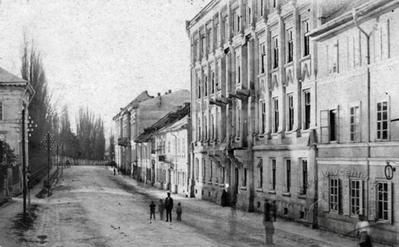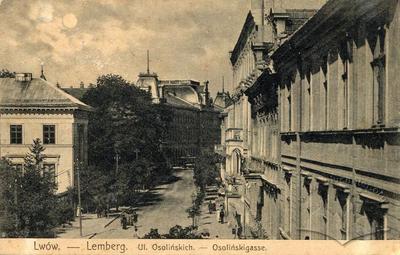Vul. Stefanyka, 11 – residential building ID: 391
This four-storied residential house was constructed in 1873-1876 under a project designed by Adolf Kuhn, a Lviv architect, for princess Jadwiga Sapieha, née Zamojska, the wife of Leon Sapieha, the Galician Sejm Marshal. It was the first residential building in the Neo-Gothic style in Lviv and the largest apartment building in the city during the pre-war period. It housed newspapers editorial offices, various societies, workshops and offices. In the 1910s the building became the property of the Ossoliński institution: except apartments, the administration was located there as well as a bookstore (from 1932). The building is an architectural monument of local significance (#280).
Story
The plot where the house stands was built up in the 18th century. There was a single-storied brick house there in the 19th century. In 1872 princess Jadwiga Sapieha, née Zamojska, the wife of Leon Sapieha, the Galician Sejm Marshal, purchased a plot located on Ossolińskich street 10 (conscription number 376 ¼, now Stefanyka street 11) to build a residential house there (DALO 2/2/4446:13). Consequently, the previous one-storied house was dismantled. The project of the house was designed by architect Adolf Kuhn (DALO 2/2/4445, p. II: 43-50), who was also the author of the project of reconstruction of the Sapieha palace situated on vul. Kopernyka, 40a.The construction was carried out in several stages. In 1873 the front part of the building up to the roof level was built; in 1874 the central part of the building and the roof were constructed. In November of 1874 the Magistrate authorized moving into the premises (DALO 2/2/4446: 25). In 1875 the back part of the building facing Tykha street was constructed (DALO 2/2/4446: 44). Permission to use all the premises was granted not earlier than 1876.
In the autumn of 1874 Jadwiga Sapieha, née Zamojska, expanded her plot by 97.53 sq. m. due to purchasing a part of the neighbouring plot number 375 ¼ (№9) from its owner Dr Kornel Szuszkiewicz. In the same year Jadwiga Sapieha was entered in the register as the only owner of the plot number 376 ¼ (DALO 2/2/4446: 26-28). In 1875 the owner asked, through the mediation of Antoni Petrykiewicz, Leon Sapieha’s secretary, to grant her exemption from rental tax for the following 25 years (DALO 2/2/4446: 31).
After the death of Jadwiga Sapieha in 1890 the house became property of her grandson Adam Stanisław who was then a student at the Catholic University of Lille (France) and later became a famous Polish religious and political figure. However, as he spent most of his time abroad, his real estate was managed by his trustees. In particular, in 1909 it was Mr Miłewski and in 1910 Dr Grzegorz Jarosławski: it was they who were addressed by the Magistrate in 1908-1910 when it was necessary to repair the building’s leaking lavatories (DALO 2/2/4446: 52-58).
Since 1911 the third tract’s left wing (facing Tykha street) was rented by the Ossoliński institution represented by Dr Bertold Frucht and Bruno Sass to locate a book bindery there as well as a paper and printed materials storehouse (DALO 2/2/4446: 68). With this in view, the rented premises were reconstructed. Apart from that, lavatories located in the rear part of the building were reconstructed under a project designed by architect Artur Schleyen in 1911-1912 (DALO 2/2/4446: 59, 63).
Later the building became fully owned by the Ossolineum institution. In the interwar period it housed the institution’s administration and the accounting and correspondence department. In the 1920s the building was connected to the sewage network, partially in 1923 and partially in 1929, some work was carried out in the 1930s (DALO 2/2/4446: 73, 75, 80). In 1927 the flat ceilings in some premises were replaced by vaulted ones laid on beams; probably, these vaulted ceilings were of the Klein system (DALO 2/2/4446: 84).
In 1926 a complaint was filed that Stanisław Krzeński, a resident of the house, arranged a wooden closet for storing various trash in the room under the skylight (the building’s central part was covered with a large skylight which has not survived) complicating the other residents’ access to their apartments. The Magistrate forced Krzeński to clear the premises, to whitewash the walls, to clean the glass roof fitting broken glasses and to remove wooden partitions etc., all this at his own expense (DALO 2/2/4445, D.1: 6, 13).
In 1927 Bruno Strzelecki, a non-commissioned officer of the Polish army and one of the tenants, complained that the wooden floor in the corridor of his apartment had rotted away and the ceiling had collapsed in the kitchen due to a water pipe leak (DALO 2/2/4445 , D.1: 19, 25). It may have been a part of this apartment which was reconstructed by architects Alfred and Kazimierz Kamienobrodzki in the same year.
In 1932 three rooms located in the front part of the house to the left of the gate, which were used as offices, were reconstructed under a project designed by engineer Tadeusz Pisiewicz. The Ossoliński institution’s bookstore was arranged there which could be entered through a door in the main façade located right next to the main gate (DALO 2/2/4445, D.1: 40). It consisted of three rooms, one of which was adapted for a reading hall. At the same time a project of a signboard reading "Księgarnia zakładu narodowego im. Ossolińskich" (The bookshop of the Ossoliński people’s institution) was designed; it was to be placed above the bookstore’s three windows.
Basing on address books, it can be said that there were mostly officials, as well as teachers and entrepreneurs among the tenants in the early 20th century. In addition to apartments and the Ossolineum institution premises, a lot of various newspaper editorial offices, societies, workshops and offices were located in the building for years. In the early 20th century a legal bureau, a joinery workshop, the editorial office of the Teachers’ Newspaper ("Gazeta Nauczycielska"), the county mutual aid fund for the sick (1902), the Society of Polish Journalists (Tow. dziennikarzy polskich), the Osnova Ruthenian Society, the "Peoples’ Education" ("Oświata Ludowa") society, the editorial office of the Galician Society of Animal Protection Monthly ("Miesięcznik Galic. Tow. Ochrony Zwierząt"), the Dental Institute (Instytut Dentystyczny), the Polish Society for Participants of the 1863-1864 Uprising, the editorial office and administration of the illustrated social and political weekly Polish Herald ("Herold Polski"), the editorial office of the “Carpathian Rus” newspaper and some others were located there.
The building has been an architectural monument of local significance under number 280 since 1980 (Lviv Regional Executive Committee’s decision №130 dated 26 February 1980). Today it is a residential house; a public organization’s office is located in the front part. Several rooms in the rear part are occupied by a cloth shop.Architecture
The building was constructed as a residential one, this being the most common type of townhouse in the 19th - early 20th century. However, it differs in that it is the second house in Lviv, which was built in the Neo-Gothic style (the first one was the monastery church of Sacre-Coeur that has not been preserved); it also was the largest pre-war apartment building in the city. It is obvious that the Sapieha family, reconstructing their palace on vul. Kopernyka, 40a in magnificent Baroque style and erecting this house, intended to strike Lvivites with their scope.This house is still one of the highest in the row housing of Stefanyka street. It borders two three-storied townhouses on each side and the Potocki Palace plot from the rear. The yard of the kindergarten № 29 (vul. Chaykovskoho, 22) is located to the south.
Due to its size the house has a shape close to the figure of 8 in plan, unlike typical L- or U-shaped configuration, with two spacious courtyards. The four-storied house is built of brick, hewn white stone blocks used; the façades are plastered. It is covered with cross vaults in the passage of the house’s front part; the other premises have flat ceilings supported by wooden beams. The stairs are wooden with a metal railing. Plaster stucco and forged metal were used in the décor of the façades and in the interior décor. According to the original design, the central part of the house had an atrium covered by a large skylight (has not been preserved). Now the building is covered with a gently sloping two-pitched roof covered by painted tin.
The house has two street façades, a main Neo-Gothic one and a Neo-Classical rear one. The symmetrical main façade has eleven axes. It is divided vertically into three parts: a rusticated ground floor separated with a stone cornice; the second and third floors divided with lesenes imitating buttresses; the fourth floor having lesenes and a massive arcature. The wall is thickened on the fifth and seventh axes and completed with stylized crenellations which can be interpreted as an imitation of medieval towers. The second and third floors balconies are the façade’s decorative accent; richly decorated with tracery, they form a single composition whole.
All windows are rectangular, only gates have arched (flat lancet) openings. The same form can be seen in the balcony décor. The windows have typical frames with facets and shaped stone windowsills. There are stylized Gothic triangular pediments above the second floor windows. The ornamentation consists above all in tracery: in the balcony arches and balustrades; in the arcature completing the façade. The tracery is mainly in the shape of a trefoil, as well as quatrefoils inscribed in a circle. In addition, typical Gothic floral ornamental designs are used in the décor, particularly in the spandrels of the balcony arches and in the frieze between the third and fourth floors.
The symmetrical Neo-Classical rear façade has 13 window axes. Compared to the main façade, its appearance is rather simple, probably in order not to compete with the neighbouring Potocki Palace architecture. In the façade composition its tectonics is accentuated: the façade is covered with chamfered rustication on the ground floor level and with banded rustication on the second floor level; above, the façade is flat. The façade’s vertical division is formed by courses between the floors. All windows are rectangular, with shaped frames having linear pediments on floors 2-4. The fifth and ninth axes are accentuated by balconies, each of which is supported by three molded consoles and has a forged metal railing. The façade is completed with an order cornice.
The building has undergone numerous alterations, when old doors were bricked up and new ones were cut. The rear part of the building, which once had a through passage, has been changed most significantly. The roof was replaced and made higher; it was then that the old skylight was demolished. Residents have made a lot of windows and balconies and arranged insulation in some parts of the wall. However, the main façade and its décor has been preserved in a sufficiently high degree.
Related buildings and spaces
People
Adolf Kuhn – Lviv-based civil architect who designed the building
Alfred Potocki – owner of the neighboring parcel on vul. Kopernyka, 15
Alfred Kamienobrodzki – architect, co-designer of some premises reconstruction
Antoni Petrykiewicz – Leon Sapieha's secretary
Antoni Schulimovicz – owner of the neighboring building, likely vul. Stefanyka, 9
Artur Schleyen – Lviv-based architect, designed the reconstruction of a part of the building's premises
Bertold Frucht, Dr – a representative of the Ossoliński Institute
Bruno Sass – a representative of the Ossoliński Institute's
Bruno Strzelecki – under officer in Polish military, former tenant
Grzegorz Jarosławski, Dr – Adam Sapieha's confidant
Jadwiga Sapieha née Zamojska (z Zamoyskich Sapieżyna) (1806–1890) – Leon Sapieha's wife, co-owner of the building
Kazimierz Witkowski, Dr – Crown Land's attorney, Kingdom of Netherlands Consul in Lviv, lawyer of Bertold Frucht and Bruno Sass
Kazimierz Kamienobrodzki – architect, co-designer of some premises reconstruction
Leon Ludwik Sapieha (1803–1878) – duke, the Galician Diet Marshal during the 1st-3rd Terms (1861-1878), a renowned Polish politician and public figure
Milewski – Adam Sapieha's confidant
Stanisław Kulikowski – building'stenant
Stanisław Macudziński – Lviv-based architect, building's tenant in 1900
Stanisław Olexiński – the Ossoliński Institute's representative, administrator of the premises in 1928
Tadeusz Piesiewicz – engineer, designed the reconstruction of some premises
Organizations
Sources
- State Archive of Lviv Oblast (DALO) 2/2/4445, p. 1.
- DALO 2/2/4445, p. 2.
- DALO 2/2/4446.
- Ksiega adresowa krolewskiego stolecznego miasta Lwowa (Lemberg, 1913).
- Księga adresowa Małopołski, Wykaz domów na obszarze miasta Lwowa (Lwów. Stanisławów. Tarnopól, 1935–1936).
- Skorowidz krolewskiego stolecznego miasta Lwowa (Lemberg, 1872).
- Skorowidz krolewskiego stolecznego miasta Lwowa (Lemberg, 1889).
- Skorowidz krolewskiego stolecznego miasta Lwowa (Lemberg, 1910).
- Spis abonentow sieci telefonicznej..., 1937.


















